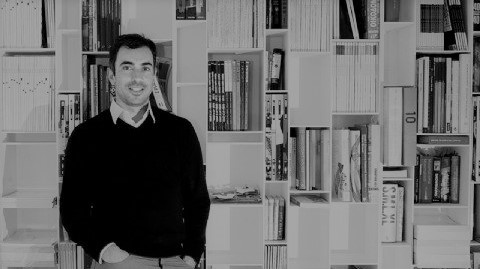
Stories Talk | Presentation Skills and Effective Storytelling
Stories Talk | Presentation Skills and Effective Storytelling
By Mia Kollia
Translated by Alexandros Theodoropoulos
#architecture #culture #art #urban #science
- Why did you choose to study architecture?
I grew up in a family of architects and engineers. My father was an architect, my uncle was an architect and my aunt was a civil engineer. My favourite toy was the magic place of a construction site. There I could do what I couldn’t do at home. Maybe at some point all of this stuck in my mind without me even realising it. Of course, I think my tendency is to express myself better with speech than with design, but architecture can be done in many different ways. That is, if we look at architecture as a language, the whole effort is how one constructs meaning.
There are some architects who have a very instinctive approach. They plan without any previous specific thought and produce an amazing result like Frank Gehry. There are others whose starting point and way of doing architecture is far outside of architecture, such as Jean Nouvel. Finally, there are architects, like Peter Eisenman, who over-analyse things so much that they can’t do architecture at all.
- In what category do you place yourself?
I am very interested in the meaning of narration, that is, in architecture I always find an opportunity to narrate things that come from what I have experienced in my life. That's why I love traveling so much.
- Have you traveled a lot?
Travelling is one of my first memories. I consider myself very lucky because my parents traveled a lot. I had been to Europe since I was very young and I think that defined my life. Hotels also seemed like magical places to me and I think that’s another part that influenced my architectural presence. The fact that I used to design hotels at a young age was not accidental, I had a special love for them.
- Did you study in London?
I did my postgraduate studies at the Bartlett School of UCL, then I lived and worked there for a while and returned to Greece in 2001. I taught Architecture at the University of Patras until 2007 and at the same time I opened an architecture office with my then colleague, Dimitra Karabelia. In 2007 I left for London again, because I found a professorship in Bartlett. Then, along with my current partner, Christina Ahtypi, we opened an architecture office in London, which I had as a professional headquarters for 15 years until I returned to Greece in 2021.
- How much has the health problem you went through affected you?
It was crucial. It is as if I have lived two lives. In my first life, as a young man, I was terribly active. I played tennis, I surfed, I skied, I had a black taekwondo belt, I did boxing! And suddenly one night, at the age of 23, I felt a pain after coming back from a football training session.
When I woke up the next morning, I didn’t feel anything from the waist down; I was disabled, quadriplegic. This is a rare lesion of the spine called transverse myelitis. It couldn’t be managed by doctors in Greece, because there was no previous experience. I stayed in the intensive care unit for a month.
Then I had to learn to live autonomously in a wheelchair. I was stuck at home and couldn’t go anywhere. So I went to Germany to do rehabilitation. I was one of the lucky ones, because the damage was reversible. I stayed in Germany for six months and when I returned to Greece, I was in a much better condition. Little by little and with specific exercise, I was getting better and better.

- After the first shock, how were you psychologically?
When you learn that your life is at a very critical juncture, you realise what it's really worth. My view of things has changed a lot since that experience. Suddenly I had a huge thirst to live, to gather experiences - that's what I wanted. To actually live!
-What is the relationship between Greece and architecture?
A friend of mine, an architect, once said that in Greece, architecture is a fruit that doesn’t bloom - and indeed it is. Greece loves the contractors more than the architects. The Greeks understand better the one who will pour concrete to build their house, than the one who will design it. I think it is also a matter of education.
Having taught in Greece and abroad, I have seen the educational system from within. I have noticed that in our country the way we learn history is only through heroic deeds. From Leonidas to Kolokotronis, this is something that happens everywhere. We don’t teach equal periods of our history when society functioned collectively and as a result we haven’t learned to work together.
- What defines your architecture office “Divercity Architects”?
First of all, the thing that has set us apart is that we understood early on that a new era was coming and we followed it. We saw globalisation as an opportunity, not as a problem. So we have done projects in the USA, in Argentina and in many European countries. We work in Qatar, in Egypt, we have an international presence. Our other basic characteristic is that we are interested in architecture not as an image but as a structure of meaning and as a narrative. This seems to be liked by the customers who trust us.
- Why are the new buildings that are being made so gray, all concrete and they all look the same?
Architecture until the 20th century had a weight, a complexity, which carried the history of the human race. We used to see that in many elements of a building. But when the modern era came, these elements slowly declined. That was a great revolution, which also showed the change in society. However, the current way of constructing has gradually been established and is now in fact reproduced as a general image. This does not express us as architects. We try to recreate buildings that carry memories and emotion, the wealth that makes them special.
- How does a collaboration start in your field?
We always listen very carefully and try to understand the person who talks to us, their ideas and visions, in order to be able to translate all this into space. The key elements to look out for are the place and the story the person tells us. For example, if they want to build a house, they can tell us how they live and that will be the starting point, because the house is the vessel of human life. If we are talking about a hotel for a larger group of people, that is different. In this case, the building should narrate something that is more universal.
- What is the most difficult part of an architectural project?
Architecture is a difficult profession. There are some architects, of course, who have found two or three things they like and reproduce them. For us, each building is different, so every time we start with a different agenda. In addition to the customer, the team that will implement our plan may be different and the human factor is very important.
The good scenario is to have a code of communication between the clients, the design team that implements their vision and the construction team that builds it. All this isn’t easy. The architect must have a great deal of communication and collaboration and the charisma of persuading others to join him. People are tied to success. So an architect should manage all the parties involved in a particular project to "see" their success through it.
- Has your teaching helped you in the field of architecture?
Teaching architecture and practising architecture are things that mutually reinforce one another. As a teacher, I wasn’t interested in imposing what I believed in, but in guiding others to get the most out of themselves. I like diversity, which is why in our office, in addition to some standards for how we understand architecture, we like the surprise that can come from discussing a new project. I also like it when people challenge me, because that moves me forward.
#HisStory